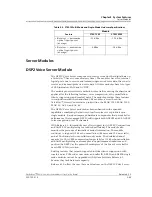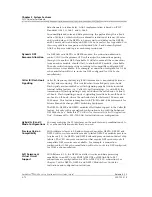
Chapter 3 System Features
DSP2 Voice Server Module
3-72
255-700-019
PacketStar
™
PSAX 20 Access Concentrator User Guide
, Issue 1
Release 6.3.0
data channels to reduce delay. AAL-2 implementation is based on ITU-T
Standards G.363, G.366.1, and G.366.2.
In nonmultiplexed voice and data processing, the payload length is a fixed
value of 40 bytes, which results in a dramatic reduction of latency (40 msec
end-to-end delay on the DSP2A, 60 msec end-to-end delay on the DSP2B,
and 22 msec end-to-end delay on DSP2C-Echo Canceler). See Appendix C in
this user guide for a comparison of standard AAL-2 and nonmultiplexed
AAL-2 cells per second (cps) at each compression rate.
Dynamic DSP
Resource Allocation
If a DSP fails on a DSP2A or DSP2B module, the connection admission
control (CAC) in the primary CPU will reassign the connections passing
through it to another DSP, if available. It will also move all the connections
from an entire module, should it fail, to another DSP2 module, if available.
The only restriction preventing re-routing is if compatibly configured DSP
resources are not available. (For example, a connection configured for G.168
echo cancellaton will not re-route to a DSP configured for G.165 echo
cancellation.)
Caller ID/Flash Hook
Signalling
Caller ID frequency shift keying (FSK) information is transmitted between
the first and second ring. This is valid when the called party is on-hook.
Flash signals are transmitted over flash signaling-capable trunks to initiate
internal calling features (i.e., Caller ID, call forwarding). As with FSK, the
transmission of flash signalling is only valid when the called end of a line is
off-hook. Flash signalling consists of signalling transitions from off-hook to
on-hook to off-hook, where the on-hook state last between 300 msec and
1000 msec. This feature is compliant with TIA/EIA-464-B Requirements for
Private Branch Exchange (PBX) Switching Equipment.
The DSP2A, DSP2B and DSP2C modules offer limited support to the Caller ID
feature, but only with a specialized configuration setup with the Enhanced
DS1 Module. See
“
PacketStar
™
PSAX Access Concentrator Caller ID Application
Note”
(Document No. 255-700-006) for instructions on configuration.
Hybrid A, B and C
Mode Configurations
You may configure the 32 interfaces on the module in any combination of A,
B, or echo cancellation modes that you need.
Previous Version
Compatibility
With software releases 6.2.0 and subsequent, modules DSP2A, DSP2B, and
DSP2C will re-route connections made to failed DSPs. For modules previous
to release 6.2.0, the DSP2A and DSP2B onboard processor cannot detect chip
failures. The CPU can route connections that require DSP resources only if
compatible DSP resources are available. For example, a connection
configured for G.168 echo cancellation will not re-route to a DSP configured
for G.165 echo cancellation.
Soft Permanent
Virtual Circuit
Support
With Release 6.3.0, the DSP2C can offer its voice and data processing
capabilities in an SPVC over PNNI, ATM UNI, or IISP link.Up to 247
connections are configurable on a CE-to-ATM VCC PVC connection. See
Chapter 7 of the DSP2A, DSP2B, and DSP2C Module User Guide for
instructions and configuration restrictions.
Summary of Contents for PacketStar PSAX 20
Page 399: ......
















































